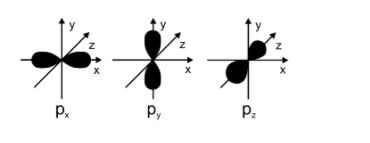
Few statements are given regarding nodes in the orbitals. Mark the statement which is not correct.
(A) In case of P, orbital, xy plane is a nodal plane
(B) ns orbital has $(n+1)$ nodes.
(C) The number of angular nodes is given by l.
(D) The total number of nodes is given by $(n-1)$ i.e. angular nodes and in $(n-l-1)$ radial nodes.
Answer
551.4k+ views
Hint To solve this question first we have to understand the term orbitals. Orbitals are 3 dimensional space around the nucleus where the probability of finding an electron is maximum.
Complete solution:
The p orbital is also an atomic orbital and the shape of p orbital is dumbbell shape. The energy levels of p orbitals are higher as compared to that of p orbitals. Angular nodes are present in the p orbitals. The maximum number of electrons which can be present in the p orbital is 6. P orbitals have 3 sub orbitals. The value of angular momentum quantum number for p orbitals is 1. There are lobes present in the p orbital.
The shape of p orbitals is mentioned below:

In case of the ${{p}_{z}}$ orbitals, the lobes are present along the z-axis and thus the nodal plane in this case is $x-y$ . for ns orbitals the total number of nodes will be equal to $n-1$
The number of angular nodes = 1 and the number of radial nodes = $n-1-1$
Hence, the total number of nodes will be equal to the sum of angular nodes and radial nodes i.e. $n-1-1+1=n-1$.
Hence, the correct answer is option (B).
Note: Do not get confused between the term orbit and orbitals. Both orbit and orbitals have different meanings as we know that orbitals are 3 dimensional space around the nucleus where the probability of finding an electron is maximum and orbits are the well-defined circular paths in which electrons revolve.
Complete solution:
The p orbital is also an atomic orbital and the shape of p orbital is dumbbell shape. The energy levels of p orbitals are higher as compared to that of p orbitals. Angular nodes are present in the p orbitals. The maximum number of electrons which can be present in the p orbital is 6. P orbitals have 3 sub orbitals. The value of angular momentum quantum number for p orbitals is 1. There are lobes present in the p orbital.
The shape of p orbitals is mentioned below:

In case of the ${{p}_{z}}$ orbitals, the lobes are present along the z-axis and thus the nodal plane in this case is $x-y$ . for ns orbitals the total number of nodes will be equal to $n-1$
The number of angular nodes = 1 and the number of radial nodes = $n-1-1$
Hence, the total number of nodes will be equal to the sum of angular nodes and radial nodes i.e. $n-1-1+1=n-1$.
Hence, the correct answer is option (B).
Note: Do not get confused between the term orbit and orbitals. Both orbit and orbitals have different meanings as we know that orbitals are 3 dimensional space around the nucleus where the probability of finding an electron is maximum and orbits are the well-defined circular paths in which electrons revolve.
Recently Updated Pages
Why are manures considered better than fertilizers class 11 biology CBSE

Find the coordinates of the midpoint of the line segment class 11 maths CBSE

Distinguish between static friction limiting friction class 11 physics CBSE

The Chairman of the constituent Assembly was A Jawaharlal class 11 social science CBSE

The first National Commission on Labour NCL submitted class 11 social science CBSE

Number of all subshell of n + l 7 is A 4 B 5 C 6 D class 11 chemistry CBSE

Trending doubts
What is meant by exothermic and endothermic reactions class 11 chemistry CBSE

10 examples of friction in our daily life

One Metric ton is equal to kg A 10000 B 1000 C 100 class 11 physics CBSE

1 Quintal is equal to a 110 kg b 10 kg c 100kg d 1000 class 11 physics CBSE

Difference Between Prokaryotic Cells and Eukaryotic Cells

What are Quantum numbers Explain the quantum number class 11 chemistry CBSE




